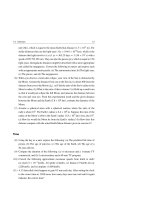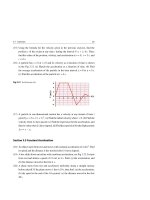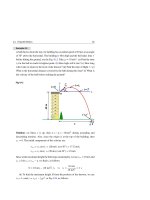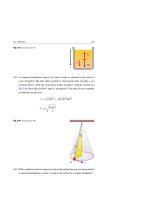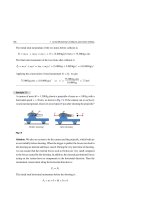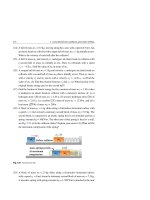Hafez a radi, john o rasmussen auth principles of physics for scientists and engineers 2 22
Bạn đang xem bản rút gọn của tài liệu. Xem và tải ngay bản đầy đủ của tài liệu tại đây (696.93 KB, 20 trang )
15.6 The Doppler Effect
521
equation will be identical to the one in part (a). Thus, the frequency f received
by an observer in sub 2 will be:
f =
15.7
1 − vo /v
1 + vS /v
f=
1 − (8 m/s)/(1,533 m/s)
1 + (10 m/s)/(1,533 m/s)
× 1,500 Hz = 1,483 Hz
Supersonic Speeds and Shock Waves
When a source moves toward a stationary object with a speed equal to the speed
of sound, i.e. when vo = 0 and vS = v, Eq. 15.39 predicts that f = (1 + 0)/(1 −
1)f = ∞, which means that f will be infinitely great. This also means that the source
is moving as fast as its generated spherical wave fronts, as suggested by Fig. 15.14.
Then the gas molecules pile up at what is called the shock front.
Fig. 15.14 A source of sound
that moves at the speed of
sound
Now what happens when vS exceeds v? For such supersonic speeds, Eq. 15.39
predicts a negative f and hence no longer applies. In such case, the speed of the
source is faster than the speed of the wave fronts as shown in Fig. 15.15 for various
source positions.
At t = 0, the source is at point S0 and at a later time t, the source is at point St , see
Fig. 15.15. At that instant, the radius of the wave front W0 which originated when
the source was at point S0 is vt. In the same time interval, the source travels a greater
distance vS t to the point St . The radius of any wave front is v multiplied by the
elapsed time since the source emitted the wave front. The tangent line drawn from
point St to the wave front centered at point S0 is the tangent of all other wave fronts
generated at intermediate times. The envelope to all of these wave fronts is a cone
called the Mach cone. This conical wave front is known as a shock wave because it is
the accumulation of all wave fronts and hence is causing an abrupt increase followed
522
15 Sound Waves
by a decrease of air pressure and then back to normal. The loud sound produced by
this shock wave is known as a sonic boom.
Conical shock front
W0
Mack cone
t
shock
θ
s>
s
St
S0
shock
Conical shock front
st
Fig. 15.15 A source of sound that moves with a speed vS greater than the speed of sound v. All the
spherical wave fronts expand at the speed of sound v and assemble along the surface of a cone called the
Mach cone, forming a shock wave
The Mach cone has an apex half-angle θ (called the Mach angle):
sin θ =
v
vt
=
vS t vS
(Mach cone half-angle)
(15.40)
The ratio vS /v is called the Mach number. When you hear that a jet plane has flown
at Mach 3, it means that its speed vS was 3 times the speed of sound (v = 343 m/s).
With this supersonic speed, the jet plane generates a shock wave which produces a
loud sound (sonic boom).
Example 15.9
A supersonic jet travels horizontally at Mach 2.5. At time t = 0, the jet is over a
person’s head at an altitude h = 10 km. (a) Where will the jet be before the ground
observer hears the boom of the shock wave? (b) How long will the person wait
before hearing that boom?
Solution: Figure 15.16 shows a sketch of the Mach cone at time t = 0, when the
jet is just above the person’s head. In addition, the figure shows the instant at time
t when the person hears the sonic boom.
15.7 Supersonic Speeds and Shock Waves
t=0
523
At time t
s
θ
h
h
s
x θ
shock
shock
shock wave
shock wave
Fig. 15.16
(a) The half-angle of the shock wave cone can be obtained as follows:
sin θ =
v
1
= 0.4
=
vS 2.5
⇒
θ = sin−1 0.4
23.6◦
From the figure’s geometry, we can find the distance x as follows:
tan θ =
h
x
⇒
x=
h
10,000 m
=
= 22,889 m = 22.9 km
tan θ tan 23.6 ◦
(b) The time the person will wait before hearing the sonic boom is:
t=
15.8
22,889 m
x
x
=
= 26.7 s
=
vS 2.5v 2.5 × (343 m/s)
Exercises
Section 15.1 Speed of Sound Waves
(1) Find the speed of sound in air when the temperature is 35 ◦ C.
(2) The bulk modulus B and density ρ of mercury at 40 ◦ C are 2.4 × 109 Pa and
13.45 × 103 kg/m3 , respectively. Calculate the speed of sound in mercury at
this temperature.
(3) Find the speed of sound in a steel rod that has a Yang’s modulus Y = 2 ×
1011 N/m2 and density ρ = 7.8 × 103 kg/m3 .
(4) A steel rod that has a Yang’s modulus Y = 2 × 1011 N/m2 , density ρ = 7.8 ×
103 kg/m3 , and length L = 100 m is struck at one end. A person at the other
end hears two sounds as a result of the propagation of two longitudinal waves,
one that traveled through the rod and the other that traveled through the air at
20 ◦ C. What is the time interval between the two sounds?
(5) The speed of a longitudinal wave in an adiabatic process is written as
√
v = Bad /ρ, where Bad = − V dP/dV as given by Eq. 10.14. In the case of
524
15 Sound Waves
an ideal gas, the relation between the pressure P and volume V during an adiabatic process is given by PV γ = constant, where γ is the ratio of the heat
capacity at constant pressure to the heat capacity at constant volume. (a) Show
that Bad = γ P for an ideal gas. (b) Show that the speed of a longitudinal wave
√
in the adiabatic process of an ideal gas is given by v = γ RT /M, where R is
the universal gas constant, T is the Kelvin temperature, and M is the molecular
mass of the gas.
(6) Hydrogen is a diatomic gas with molecular mass M = 2 kg/kmol and γ = 1.41.
Find the speed of sound in hydrogen gas at 27 ◦ C.
(7) The auto-focusing mechanism of old cameras used to depend on the camera
sending a high frequency ultrasonic sound pulse toward the object being photographed. The camera would calculate the time that the pulse would take from
the moment it left the camera to the moment it was detected by the camera’s
sensor. Based on the travel time of such a pulse, the camera would adjust its
lens automatically. If the speed of sound in air is 343 m/s, find the travel time
of a pulse for an object: (a) 1.5 m away, and (b) 5 m away.
(8) A fishing boat emits an ultrasonic pulse vertically toward the sea bed. Then
pulse is received 1.5 s after being reflected from the ocean floor. If the speed
of sound in sea water is 1,560 m/s, how far down is the ocean floor from the
boat’s location?
(9) On a warm summer day (32.3 ◦ C), a boy drops a stone from the top of a cliff.
Using his stopwatch, he finds that it took 20.9 s from the moment he dropped
that stone until the moment he hears the sound of the splash that the stone
makes with the surface of the water below. Take g = 9.8 m/s2 . How high is the
cliff?
Section 15.2 Periodic Sound Waves
(10) The pressure variation in a periodic sound wave is given by:
P = (2 Pa) sin π [(2 m−1 )x − (686 s−1 )t]
(a) Find the pressure-variation amplitude. (b) Find the wavelength and frequency of the pressure wave. (c) Find the speed of the pressure wave.
(11) A sinusoidal sound wave has the following displacement:
s(x, t) = (4 µm) cos[(20 m−1 )x − (6860 s−1 )t]
15.8 Exercises
525
(a) Find the displacement amplitude, wavelength, frequency, and speed of the
wave. (b) Find the value of the displacement of an element of air at the position
x = 2 mm at time t = 2 ms. (c) Find the maximum speed of this oscillating
element.
(12) In homogenous air of density ρ = 1.21 kg/m3 a sinusoidal periodic sound
wave has a wavelength λ = 0.2 m, speed v = 343 m/s, and pressure-variation
amplitude Pmax = 0.5 Pa. (a) Show that the function that describes the
pressure-variation depends on position x and time t according to the following
expression:
P = (0.5 Pa) sin π [(10 m−1 )x − (3,430 s−1 )t]
(b) Show that the function that describes the displacement of an element of air
is governed in position and time by the following expression:
s(x, t) = (0.112 µm) cos π [(10 m−1 )x − (3,430 s−1 )t]
(13) To generate a sound wave of speed v = 343 m/s and displacement amplitude
smax = 5.5 µm in air of density ρ = 1.2 kg/m3 , one finds that the pressurevariation amplitude Pmax has to be limited to a maximum value of 0.84 Pa.
What is the minimum wavelength that the sound wave can have?
Section 15.3 Energy, Power, and Intensity of Sound Waves
(14) Figure 15.17 depicts a very long open tube of area A = 5 × 10−3 m2 that was
filled at normal atmospheric pressure with air that has a density ρ = 1.2 kg/m3 .
When the piston is driven at a frequency of 500 Hz and amplitude of 0.15 cm,
a sinusoidal sound wave with a speed v = 343 m/s is maintained in the tube.
What power must be supplied by the piston to produce this sound wave?
Oscillating piston
with frequency f
Compression
Expansion
λ
Cross
sectional
area A
Fig. 15.17 See Exercise (14)
(15) A sound source vibrates at 1 kHz and produces sound waves of intensity
0.5 W/m2 at a fixed point in space. (a) Find the intensity at this point if
526
15 Sound Waves
the frequency is doubled while the displacement amplitude is kept constant.
(b) Find the intensity at this point if the frequency is halved while the displacement amplitude is tripled.
(16) A loudspeaker emits a sound intensity of 100 µW/m2 in a circular tube of radius
r = 7.5 cm. How much power is being radiated as sound by the loudspeaker?
(17) Sound waves propagate with the same intensity I and angular frequency ω in:
(1) air of density ρa = 1.29 kg/m3 with a speed va = 331 m/s and, (2) water of
density ρw = 1,000 kg/m3 with a speed vw = 1,493 m/s. Find the following for
the two media: (a) the ratio of the values of the wavelength, (b) the ratio of
the values of the displacement amplitude, and (c) the ratio of the values of the
pressure-variation amplitude. (d) When I = 10−6 W/m2 and ω = 2,000π rad/s,
evaluate the wavelength, displacement amplitude, and the pressure variation
amplitude in each medium.
(18) The area of human eardrum is about A = 5 × 10−5 m2 . The intensity of sound
at the threshold of hearing is I = 10−12 W/m2 and at the threshold of pain is
I = 1 W/m2 . Find the sound power incident on the eardrum at both thresholds.
Section 15.4 The Decibel Scale
(19) When the human auditory system experiences a sound intensity of 1.2 W/m2
it results in pain. Represent this amount in decibels.
(20) When a person speaks loudly, the sound level produced is 70 dB. When that
person speaks normally, the sound level generated is at 40 dB. Find the ratio
of the intensities of the two sounds.
(21) Two students argue loudly at sound levels of 80 dB and 78 dB. (a) Find the
sound intensities for the individual students. (b) Find the combined sound level
when the students argue simultaneously.
(22) (a) Show that doubling the intensity of sound will increase its level by 3 dB.
(b) Show that halving the intensity of sound will decrease its level by 3 dB.
(23) One stereo amplifier is rated at 80 W and another is rated at 120 W. If the
intensity of the sound produced at the maximum level of the first amplifier is
taken as a reference, how much louder in dB will the second amplifier be at the
maximum level?
(24) An engineer standing in front of an airplane with its four engines running
experiences a sound level of 135 dB. What sound level would the engineer
15.8 Exercises
527
experience if the pilot shut down: (a) only one engine, and (b) only two engines,
and (c) only three engines?
(25) The amplitude of a sound wave is increased by a factor of 2.25. (a) By what
factor will the intensity increase? (b) By how many dB will the sound level
increase?
(26) Two identical point sources, S1 and S2 , are located from an observer as shown
in Fig. 15.18. They are emitting sound waves with the same power from the
same oscillator. The sound intensity at the observer’s location from S2 is
I2 = 4.0 × 10−6 W/m2 . (a) Find the total intensity of sound waves that is
received by the observer from the two sources. (b) Find βtot − β2 , which
is the difference in the sound level when the two sources operate together
and when the second source operates by itself. (c) Show that β1 − β2 =
(20 dB)log(r2 /r1 ) = 9.54 dB.
r1
r2 = 3 r1
S1
S2
Fig. 15.18 See Exercise (26)
Section 15.5 Hearing Response to Intensity and Frequency
(27) What is the ratio of highest to lowest intensity that our auditory system can
accommodate at: (a) 100 Hz, and (b) 1,000 Hz? (Use Fig. 15.9)
(28) What are the lowest and highest frequencies that our auditory system can detect
if the sound level for normal talking is 50 dB? (Use Fig. 15.9)
Section 15.6 The Doppler Effect
(29) A source emits a 2.5 kHz sound wave. If this source moves toward you at 20 m/s
while you stay still, will the observed frequency be the same as if you moved
toward the source at 20 m/s while it stays still?
528
15 Sound Waves
(30) While at rest, a bat sends out ultrasonic sound at 45 kHz. What is the bat’s
received sound frequency if that sound wave strikes a mouse running away
with a speed of 20 m/s?
(31) While a bat is flying toward a wall at a speed of 5 m/s, it emits an ultrasonic
sound of 35 kHz. What frequency does the bat receive from the reflected wave?
(32) A man holding an oscillating tuning fork with a frequency f = 200 Hz, runs
toward a wall with a speed vm = 5 m/s, see Fig. 15.19. The speed of sound in air
is 343 m/s. (a) What frequency difference does he observe between the tuning
fork and its echo? (b) How fast must he run away from the wall to observe a
difference in frequency equal to 5 Hz?
Fig. 15.19 See Exercise (32)
m
f
Wall
(33) An observer hears a frequency of 530 Hz from the siren of an approaching train;
see part (a) of Fig. 15.20. After the train passes, the observer nearly in the path
of the train hears a frequency of 470 Hz, see part (b) of Fig. 15.20. The speed
of sound is 343 m/s. Find the train’s speed.
Fig. 15.20 See Exercise (33)
(34) A school bus moving with a speed vb = 15 m/s generates a whistling sound at a
frequency fb = 300 Hz, see Fig. 15.21. A truck approaches the bus with a speed
vt = 30 m/s while its engine rumbles at a frequency ft = 500 Hz. The speed of
sound in air is 343 m/s. Assume approximately collinear paths. (a) What is
the frequency detected by the driver in the truck? (b) What is the frequency
detected by an observer in the bus? (c) After the truck passes the bus, what is
the frequency detected by an observer in the bus?
15.8 Exercises
529
(35) Two trams, A and B have identical sirens of frequency 500 Hz. Tram A is
stationary and Tram B is moving towards the right, away from A at a speed
of vB = 35 m/s. An observer between the two sirens moves towards the right
with a speed vo = 20 m/s, see Fig. 15.22. Assume the speed of sound in air to
be 340 m/s. (a) With what frequency does the observer hear the siren emitted
from tram A? (b) With what frequency does the observer hear the siren emitted
from tram B? (c) What is the difference in frequency heard by the observer?
fb
b
ft
t
Fig. 15.21 See Exercise (34)
f
o
A
f
B
B
Fig. 15.22 See Exercise (35)
(36) A siren on the top of a stationary fire engine emits sound in all directions at a
frequency f = 900 Hz. Assume that the speed of sound in calm air is 343 m/s
and that a steady wind is blowing towards the East with a speed of 15 m/s. (a)
Find the wavelength of the sound East of the siren. (b) Find the wavelength of
the sound West of the siren. (c) Find the frequency of the sound heard when a
firefighter approaches the siren with a speed of 15 m/s while walking against the
wind. (d) Find the frequency of the sound heard when a firefighter approaches
the siren with a speed of 15 m/s while walking with the wind.
Section 15.7 Supersonic Speeds and Shock Waves
(37) The Concorde could fly at Mach 1.5. The speed of sound is 340 m/s. (a) What
does Mach 1.5 means? (b) What is the angle between the direction of the
propagation of the shock wave front and the direction of the plane’s velocity?
530
15 Sound Waves
(38) A supersonic jet is traveling horizontally at Mach 3. At t = 0, the jet is over
a person’s head at an altitude h = 15 km, see the left part of the sketch in
Fig. 15.23. (a) Where will the jet be before the person hears the boom of the
shock wave, see the right part of the sketch in Fig. 15.23? (b) How long will
the person wait before hearing that boom?
At time t
s
t=0
x
θ
h
h
s
θ
shock
shock
shock wave
shock wave
Fig. 15.23 See Exercise (38)
(39) A jet plane travels at Mach 2.5. The speed of sound is 320 m/s. (a) Find the
angle of the shock wave compared to the direction of the jet’s motion. (b) If the
jet is flying h = 6 km vertically above a person on the ground, how long will it
take for that person to hear the shock wave?
(40) A supersonic rocket travels at a constant speed of 1,190 m/s in a direction
making an angle φ with the horizontal, see the sketch in Fig. 15.24. As the
rocket gains altitude, an observer on the ground hears for the first time the
boom of the shock wave when the rocket is directly above him. Assume the
speed of sound in air to be 340 m/s. (a) Find the angle φ. (b) If the rocket is
above the person at an altitude h = 10 km, find the time of flight. (c) Find the
horizontal displacement of the rocket.
shock
s
shock wave
front
shock wave
front
φ
Fig. 15.24 See Exercise (40)
vshock
16
Superposition of Sound Waves
In this chapter, we explore the phenomenon that occurs when combining two or more
waves at one point in the same medium. This phenomenon is known as interference.
We first combine waves having the same frequencies. Then we combine waves that
have slightly different frequencies. In both cases we only consider waves with small
amplitudes so that we can use the superposition principle.
16.1
Superposition and Interference
To analyze complex combinations of traveling waves where each wave has a small
amplitude, we use the superposition principle:
The Superposition Principle
If y1 and y2 are two traveling waves produced separately by two sources, then
the resultant wave y at any point is the algebraic sum y1 + y2 when the two
sources act together.
This principle is extremely important in all types of wave motion and applies not
only to sound waves, but to string waves, light waves, and, in fact, to wave motion
of any sort.
The general term interference is applied to the effect produced by two (or more)
traveling waves when they are simultaneously passing through a given region. When
the resultant wave has larger amplitude than that of either individual wave, we refer
to their superposition as constructive interference. However, when the resultant
H. A. Radi and J. O. Rasmussen, Principles of Physics,
Undergraduate Lecture Notes in Physics, DOI: 10.1007/978-3-642-23026-4_16,
© Springer-Verlag Berlin Heidelberg 2013
531
532
16 Superposition of Sound Waves
wave has smaller amplitude than that of either individual wave, we refer to their
superposition as destructive interference.
Superposition of Sinusoidal Waves
Let us apply the principle of superposition to two sinusoidal waves traveling to
the right in a homogeneous medium and having a different phase φ but the same
frequency f, wavelength λ, and amplitude A. Accordingly, we write their individual
waves as follows:
y1 = A sin(kx − ω t),
(16.1)
y2 = A sin(kx − ω t + φ)
where, as usual, k = 2π/λ, ω = 2π f , and φ is the phase constant. The superposition
of y1 and y2 gives the following resultant:
y = y1 + y2 = A [sin(kx − ω t) + sin(kx − ω t + φ)]
(16.2)
To simplify the previous expression, we use the trigonometric identity:
sin a + sin b = 2 cos
a−b
a +b
sin
2
2
(16.3)
If we substitute in this identity with a = kx−ω t and b = kx−ω t +φ, then a−b = −φ
and a + b = 2kx − 2ω t + φ. Accordingly, we will find that the resultant wave y is
reduced to:
y = 2A cos
φ
2
sin kx − ω t +
φ
2
(16.4)
The resultant wave y has the following important characteristics:
(1) It is a sinusoidal wave and has the same frequency f and wavelength λ as any
one of the contributing waves y1 and y2 ,
(2) It has an amplitude of 2A cos(φ/2),
(3) It has a phase of φ/2.
Now, let us consider the following three cases:
(a) If φ = 0, then cos(φ/2) = + 1 and the amplitude of y is +2 A, i.e. twice the
amplitude of either one of the individual waves. In this case, the waves are
said to be in phase and thus interfere constructively, see Fig. 16.1a. In general,
16.1 Superposition and Interference
533
constructive interference occurs if the phase φ is an even multiple of π, i.e.
φ = 0, 2π, 4π, . . . rad, then cos(φ/2) = ±1.
(b) If φ is an odd multiple of π, i.e. φ = π, 3π, 5π, . . . rad, then cos(φ/2) = 0,
and the crests of one wave occur at the same positions as the troughs of the
second wave to produce a resultant amplitude of zero. In this case, the waves
are canceling each other out and are said to be out of phase and thus interfere
destructively, see Fig. 16.1b.
(c) If φ has an arbitrary value other than an odd or even multiple of π, then the
resultant wave has an amplitude between 0 and 2 A, see Fig. 16.1c.
y
y
y1
and
y2
y
are identical
x
0
y1
y2
y
x
0
φ = 0°
φ =180°
(a)
(b)
y
y
y1
y2
x
0
φ = 60 °
(c)
Fig. 16.1 Two identical waves, y1 (blue) and y2 (green), traveling in the same direction are added to
each other at time t = 0 to give a resultant wave y (red). (a) When y1 and y2 are in phase (φ = 0), they
undergo constructive interference with a resultant wave y = y1 + y2 that has double the amplitude of
either one of y1 or y2 . (b) When y1 and y2 are out of phase (φ = π rad = 180◦ ), they undergo destructive
interference with a resultant wave y = y1 + y2 = 0, i.e. they cancel each other out. (c) When the phase
is different from 0 or π rad, the resultant wave y falls somewhere between part (a) and part (b)
16.2
Spatial Interference of Sound Waves
Figure 16.2 depicts an acoustic interferometer device used to demonstrate sound
interference. Sound energy from the source S is divided into two equal parts at the
534
16 Superposition of Sound Waves
T-shaped junction of the tube. This means that the sound wave that reached the
receiver R traveled along either path A or path B. The distance along any path is
called the path length L. The upper path length LA is adjusted by a U-shaped tube,
while the lower path length LB is kept fixed.
Sliding
tube
Path A
LA
S
R
LB
Path B
Fig. 16.2 A device used to demonstrate the interference of sound waves. Sound energy from the speaker
(S) is divided into two parts at the T-shaped junction of the tube. Before reaching the receiver (R), half of
the wave energy propagates through path A of length LA , while the other half propagates through path B
of length LB . The upper path length LA can be varied by sliding the U-tube up or down
Constructive interference occurs when the difference in the path length
L = |LA − LB | is given by:
λ
L = |LA − LB | = (2n) , n = 0, 1, 2, . . .
2
Constructive
interference
(16.5)
Therefore, the two waves reaching the receiver at any time are in phase (φ = 0,
2π, 4π, . . . rad), as shown in Fig. 16.1a, and hence a maximum sound intensity is
detected at the receiver R.
Destructive interference occurs when the difference in the path length
L = |LA − LB | is given by:
λ
L = |LA − LB | = (2n + 1) , n = 0, 1, 2, . . .
2
Destructive
interference
(16.6)
Therefore, the two waves reaching the receiver at any time are completely out of phase
(φ = π, 3π, 5π, . . . rad), as shown in Fig. 16.1b, and hence no sound is detected at
the receiver R.
16.2 Spatial Interference of Sound Waves
535
Because a path difference of a complete wave length λ corresponds to a phase
L to the phase angle φ by the
angle of 2π rad, one can relate path difference
relation:
L=
φ
λ
2π
(16.7)
Example 16.1
Two identical speakers, S1 and S2 , are placed horizontally at a distance d = 2 m
apart. Each emits sound waves of wavelength λ = 80 cm driven by the same oscillator, see Fig. 16.3. A listener is originally located at point O, which is midway
between the two speakers. The listener walks to point P, which is a distance x
from O, and reaches the first minimum in sound intensity. Find x.
.
S2
.
x
O
S1
P
d/2
d/2
Fig. 16.3
Solution: If L1 and L2 are the distances from S1 and S2 to point P, respectively,
then according to Fig. 16.3 we have:
L1 =
d
d
− x, L2 = + x
2
2
From these two relations and Eq. 16.6, the condition for the first destructive interference at point P leads to the following:
|L2 −L1 | =
λ
2
⇒
d
d
+x −
−x
2
2
=
λ
2
⇒
x=
λ 80 cm
=
= 20 cm
4
4
Example 16.2
Two identical speakers, S1 and S2 , are placed vertically at a distance d = 2 m apart
and emit sound waves driven by the same oscillator, see Fig. 16.4. A listener is
536
16 Superposition of Sound Waves
originally located at point O, which is a distance R = 5 m from the center of the
line connecting the two speakers. The listener walks to point P, which is a distance
y = 0.5 m above O, and thus reaches the first minimum in sound intensity. Find
the wavelength λ of the sound wave.
S1
L1
d/2-y
.
.
P
d/2
R
d/2
y
O
d/2+y
L2
S2
Fig. 16.4
Solution: The first minimum in sound intensity occurs when the two waves reaching the listener at point P are 180◦ out of phase. In other words, when their path
difference equals λ/2. As per Fig. 16.4, we first calculate the path lengths L1 and
L2 as follows:
L1 =
R2 + (d/2 − y)2 =
(5 m)2 + [(2 m)/2 − 0.5 m]2 = 5.0249 m
R2 + (d/2 + y)2 =
(5 m)2 + [(2 m)/2 + 0.5 m]2 = 5.2202 m
and
L2 =
Thus, from Eq. 16.6, the first destructive interference at point P leads to the following:
|L2 − L1 | =
λ
2
⇒
|5.2202 m − 5.0249 m| = λ/2
Therefore:
λ = 0.3906 m = 39.06 cm
⇒
0.1953 m = λ/2
16.3 Standing Sound Waves
16.3
537
Standing Sound Waves
Assume we have two identical sound sources that face each other as shown in Fig. 16.5
and driven by the same oscillator. In this case, they produce two identical traveling
waves each with a speed v. These waves would be moving in opposite directions in the
same medium. Of course, these two waves combine according to the superposition
principle.
Fig. 16.5 Two identical sound sources emitting traveling waves towards each other, each with a
speed v. When the two waves overlap, they produce standing waves (not shown in the figure)
To analyze this situation, we assume that the two sound sources generate sound
waves that have the same frequency f, wavelength λ, and amplitude A but differ
by traveling in opposite directions. Therefore, we can write these two waves in the
following form:
y1 = A sin(kx − ω t),
y2 = A sin(kx + ω t)
(16.8)
where y1 represents a wave traveling in the positive x-direction and y2 represents a
wave traveling in the negative x-direction. The superposition of y1 and y2 gives the
following resultant:
y = y1 + y2 = A [sin(kx − ω t) + sin(kx + ω t)]
(16.9)
To simplify this expression, we use the trigonometric identity:
sin(a ± b) = sin a cos b ± cos a sin b
(16.10)
If we substitute in this identity with a = k x and b = ω t, then the resultant wave y
reduces to:
y = (2 A sin kx) cos ω t
(16.11)
538
16 Superposition of Sound Waves
The resultant y represented by Eq. 16.11 gives a special kind of simple harmonic
motion in which every element of the medium oscillates in simple harmonic motion
with the same angular frequency ω (through the factor cos ω t) and an amplitude
(given by the factor 2 A sin kx) that varies with position x. This wave is called a
standing wave because there is no motion of the disturbance along the x-direction.
A standing wave is distinguished by stationary positions with zero amplitudes
called nodes (see Fig. 16.6). This happens when x satisfies the condition sin kx = 0,
that is, when:
kx = 0, π, 2π, 3π, . . .
When using k = 2π/λ, these values give x = 0,
x = 0,
3λ
λ
, λ,
, . . . , that is:
2
2
3λ
λ
λ
, λ,
, . . . = n , (n = 0, 1, 2, . . .)
2
2
2
(Nodes)
(16.12)
In addition, a standing wave is distinguished by elements with greatest possible
displacements called antinodes (see Fig. 16.6). This happens when x satisfies the
condition sin kx = ±1, that is, when:
kx =
π 3π 5π
,
,
, ...
2 2
2
λ 3λ 5λ
Also, using k = 2π/λ, these values give x = ,
,
, . . . , that is:
4 4
4
x=
λ 3λ 5λ
λ
,
,
, . . . = (n + 21 ) , (n = 0, 1, 2, . . .)
4 4
4
2
(Antinodes)
(16.13)
Equations 16.12 and 16.13 indicate the following general features of nodes and
antinodes (see Fig. 16.6):
Soptlight
(1) The distance between adjacent nodes is λ/2.
(2) The distance between adjacent antinodes is λ/2.
(3) The distance between a node and an adjacent antinode is λ/4.
16.3 Standing Sound Waves
539
y
A
When
t= 0
When
t = p /2
When
t= p
o
2 A sin k x
A
A
A
.........x
N
N
N
Antinode=A
Node=N
N
N
λ
Fig. 16.6 The time dependence of the vertical displacement (from equilibrium) of any individual element
in a standing wave y is governed by cos ω t. Each element vibrates within the confines of the envelope
2 A sin kx. The nodes (N) are points of zero displacement, and the antinodes (A) are points of maximum
displacement
In Fig. 16.7a, at t = 0 (ω t = 0), the two oppositely traveling waves are in phase,
producing a wave pattern in which each element of the medium is experiencing its
maximum displacement from equilibrium. In Fig. 16.7b, at t = T /4 (ω t = π/2), the
traveling waves have moved one quarter of a wavelength (one to the right and the
other to the left). At this time, each element of the medium is passing through the
equilibrium position in its simple harmonic motion. The result is zero displacement
for each element at all values of x. In Fig. 16.7c, at t = T /2 (ω t = π ), the traveling
waves are again in phase, producing a wave pattern that is inverted relative to the
t = 0 pattern. The patterns at t = 3T /4 and t = T are similar to t = T /4 and t = 0,
respectively.
y
y
1
y
y
y
1
.
A
.
A
(a) t = 0
y
2
. . . . . x
N
.A N N .A N
N
1
y
. . . . .
N
N
N
N
(b) t = T / 4
N
2
y
x
.
A
.
y
A
. . . . .
. N N A. N N
A
N
2
x
(c) t = T / 2
Fig. 16.7 Standing-wave patterns resulting from two oppositely traveling identical waves y1 and y2 at
different phases. The displacement is zero for each node (N), and is maximum for each antinode (A)
540
16 Superposition of Sound Waves
Example 16.3
Two opposing speakers are shown in Fig. 16.8. A standing wave is produced
from two sound waves traveling in opposite directions; each can be described as
follows:
y1 = (5 cm) sin(4x − 2 t),
y2 = (5 cm) sin(4x + 2 t).
where x and y, are in centimeters and t is in seconds. (a) What is the amplitude of
the simple harmonic motion of a medium element lying between the two speakers
at x = 2.5 cm? (b) Find the amplitude of the nodes and antinodes. (c) What is the
maximum amplitude of an element at an antinode?
Fig. 16.8
Standing wave
Speaker
0
Speaker
x
Solution: (a) Using the general form of a standing wave given by Eq. 16.11, we
find A = 5 cm, k = 4 rad/cm, and ω = 2 rad/s. Thus:
y = (2 A sin kx) cos ω t = [(10 cm) sin(4x)] cos(2t)
The amplitude of the simple harmonic motion of an element lying between the two
speakers at x = 2.5 cm is the absolute value of the coefficient of cos(2t) evaluated
at this point. Thus:
Amplitude = |(10 cm) sin(4x)|x = 2.5 |
= |(10 cm) sin(10 rad)| = |−5.4 cm| = 5.4 cm
(b) With k = 2π/λ = 4 rad/cm, we have λ = π/2 cm. Then, from Eq. 16.12 we
find that the nodes are located at:
x=n
π
λ
= n cm, (n = 0, 1, 2, . . .)
2
4
From Eq. 16.13, we find that the antinodes are located at:
x = (n + 21 )
λ
π
= (n + 21 ) , (n = 0, 1, 2, . . .)
2
4
(c) The maximum amplitude of antinodes will be 2 A = 10 cm

